Home/Information/Mountain Huts
Mountain Huts in the Alps
There is a unique network of manned mountain huts in the Alps. This fact lets us organize multi-day hiking trips with a fairly good level of comfort. Our hut-to-hut hiking tours can be as long as 14 days, but our guests always stay overnight comfortably, can take a hot shower and enjoy local cuisine. From this article, you can learn what services the alpine huts provide, when they open and close, what you need to bring for a night and lots of other useful information.
In the Alps, the history of mountain huts dates back to the second half of the 19th century - the Golden Age of alpinism. The first huts were constructed to serve as shelter in case of adverse meteorological conditions and as base camps for ascents to the Alps’ highest summits. That time, huts were tiny and spartan. Since the second half of the 20th century, most huts have undergone several upgrades and have become comfortable establishments equipped with most facilities we are used to.
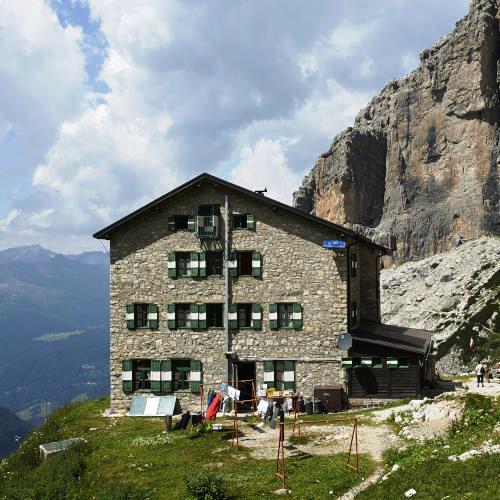
Huts are manned during the summer and offer lodging and meals
Today, a typical alpine hut is a stone building of two or three floors. Large huts are comfortable for 70-90 guests, while the smallest ones can accommodate not more than 15-20 guests at a time. Alpine huts are not spartan anymore. They feature electricity as well as water supply, plumbing and sewerage systems which are often autonomous. This infrastructure allows huts to provide the services typical of a simple hotel.
Types of Alpine Huts
Most huts in the Alps are owned by the national alpine clubs and their territorial units. Also, huts can be owned privately by individuals and by communities, museums, national parks, youth associations and other institutions.
In the Italian Alps, the huts feature all types of ownership. Most huts are owned by the Italian Alpine Club or CAI. A significantly smaller share of the Italian huts are owned by individuals. Huts with the other forms of ownership are rare in the Italian Alps.
Regardless of the type of ownership, huts must comply with certain rules that define sanitary standards and minimum set of services
The Italian Alpine Club rents its huts out or, in exceptional cases, appoints managers to run them. Hut managers are normally local residents passionate for mountains, and they are often former professional mountain guides. All CAI huts must follow a unified regulation, which covers all aspects of operation including the provision of services and pricing. The purpose of the unified regulation is to guarantee operation of huts even in the most distant and isolated locations.
Private huts in the Italian Alps are mostly owned by families. Ownership of a hut in the 3th or 4th generation is not unusual. Normally, families run their huts on their own with help from seasonal employees. Managers of private huts have more freedom in the operational management of their huts as opposed to the CAI-owned huts.
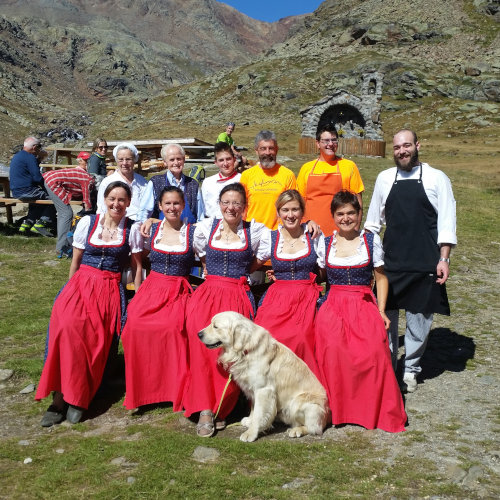
Both private and Alpine Club huts are normally managed by families
There is an opinion that a private hut is always better than a CAI hut. We do NOT confirm this being a rule. We have seen examples of excellent management on each side. In fact, managers of most CAI huts rent the building from CAI. They are not paid salaries from CAI. Quite the contrary, they pay the rent to CAI. It is a cost the private huts do not have. Having paid the rent, the CAI hut managers operate their huts on a commercial basis. Reputation is equally important for the managers of both CAI and private huts.
Huts Opening and Closing Dates
Weather is the key fundamental factor defining the demand for huts’ services. Based on decades of meteorological statistics, most huts open around June 20 and close around September 20. For the CAI huts, these dates are obligatory. The huts set at higher altitude may be allowed to open later and close earlier. The minimal obligatory opening period is defined by CAI, but hut managers are permitted to open earlier and close later.
Privately owned huts do not need to follow the regulation of CAI. Owners can freely decide on the opening and closing dates. Normally, the opening period of private huts is similar to that of the CAI huts in the area, or it differs insignificantly, because this is when there are hikers on the trails.
Overall, the opening period of the huts is longer in the more popular mountains. In some areas of the Dolomites, huts open in the second week of June and stay open until the middle of October, thus making accessible hut-to-hut itineraries that rely on 4-5 huts in the chain. If you are planning a hut-to-hut trek in the Dolomites, our article Hiking Season in the Dolomites can provide you with information on which itinerary is optimal and on what dates
Meals in Mountain Huts
Alpine huts feature a simple restaurant or dining room where the personnel serve breakfast, lunch and dinner on a schedule. As a rule, huts set at lower altitudes and with access on road are able to offer more choice in their menu. In comparison with them, distant and isolated huts have limited possibilities. In any case, all huts are able to offer choices. Meals in huts can be simple but always with the flavour of the traditional cuisine of that specific part of the Alps.
Breakfast time varies from hut to hut, but it is normally served from 7 to 9. Most huts offer buffet breakfast, which normally includes butter, bread, pastries, jams, honey, cheese and sausages, juice and yogurt.
Our hiking trips include breakfast and dinner at huts
Dinner is served on a schedule at most huts. It typically starts at 7 or 7:30 pm. We recommend asking the hut personnel about the exact serving time in advance as the dinner is served to all guests at the same time. A typical dinner in huts is very rich and includes a set with a starter, first course (such as soup, pasta, risotto, dumplings), main course (typically, meat with a side dish) and dessert. All huts offer 2-3 choices of dishes if they serve a set dinner. Huts offering a-la-carte dinner are not unusual, but dinner is in any case included in the cost of our hut-to-hut trips. Drinks at dinner can be ordered individually and are not part of half board arrangements, and thus need to be paid separately.
Lunch. It is possible to stop for lunch in the mountain huts along the route on most of our hut-to-hut itineraries. Lunch is always offered a-la-carte. The menu choices for lunch are similar to the dinner choices. There is a selection of first courses for EUR 7 -10 and of main dishes for EUR 13 - 16.
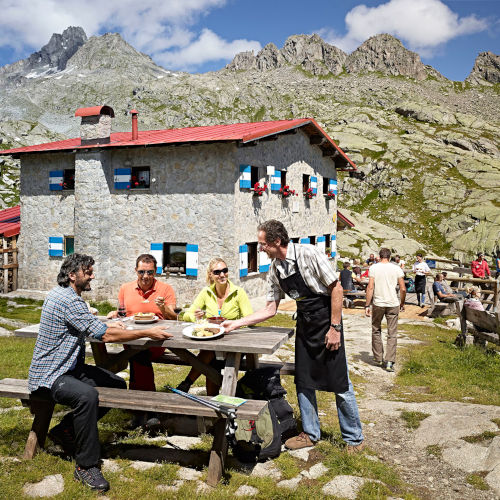
Normally, you can stop for lunch in one of the mountain huts along your route
Packed lunch is available for purchase in all huts. It normally includes sandwiches, chocolate, cookies and water. We recommend agreeing on the composition of your packed lunch in the evening so that you just need to collect it in the morning and you do not lose time waiting (morning is busy time in huts).
Dietary considerations. All huts can meet vegetarian, vegan and celiac dietary requirements. Dietary requirements need to be communicated to the huts in advance. Our trip registration form collects this information. Please use the form to communicate your dietary requirements to us - we will pass this information to the huts and hotels you will stay at. In any case, we recommend reminding the hut personnel about your dietary requirements when you check in.
Be sure to inform us of your dietary requirements in your trip registration form - huts need this information in advance
Water. Tap water may not be drinkable in huts depending on its source and the purification system used in the hut. Please verify it with the hut personnel whether the tap water is good for drinking if you would like to refill your bottle. Huts sell water in plastic bottles. Typical price in the Italian and French Alps is 1 euro for a 0,5-liter bottle.
Accommodation in Mountain Huts
Most huts offer accommodation in dormitories and private rooms. In a typical hut, the total capacity of dormitories is significantly larger than that of its all private rooms. Normally, a dormitory is shared by 8-16 guests. Larger dormitories exist, but smaller dormitories are more common. Dormitories are usually equipped with bunk beds one next to another. In alternative, many huts offer rooms for two, three or four guests for private use. Private rooms must be booked in advance. Mattresses, blankets and pillows are provided in both dormitories and private rooms. Use of a sleeping bag liner is obligatory in dormitories, while private rooms normally feature bed linen. To find out whether you need to bring liners or can count on having bed linen provided, please consult your Reservation document - it contains such details for each of your huts.
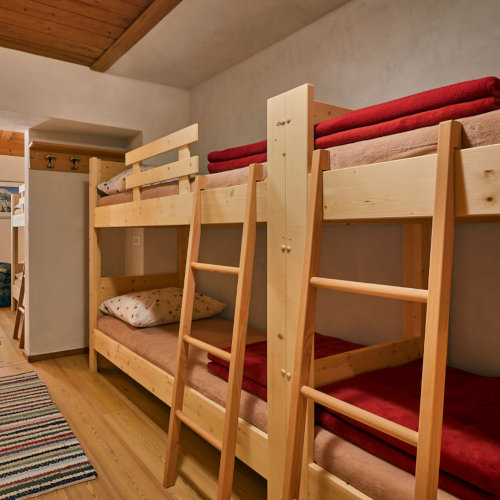
Most huts feature both shared dormitories and private rooms
Bathrooms and Showers
Almost all huts nowadays feature bathrooms with hot showers. Typically, bathrooms are shared. Use of shower is not included in the half board arrangement at most huts and costs 3-5 euro. If the cost of showers exceeds this range, it is due to the extreme water scarcity in this location. Showers may even be temporarily unavailable in such locations during dry periods. Fortunately, such locations are very few in the Alps.
Heating
There is normally an autonomous heating system in the huts to maintain comfortable temperature in the bedrooms. Hut managers cannot afford using it extensively, but in fact it is rarely necessary. Huts at high altitudes do not open until the outside temperature allows minimal use of the heating system. In the most authentic huts, the dining room can feature a wood stove or fireplace.
Electricity, sockets and plugs
There are electric sockets in mountain huts. You can charge mobile phones, cameras and other portable appliances. Use of power-intensive appliances is not permitted in the huts as the power is strictly limited. The most distant huts generate the electric energy autonomously, thus it is limited and expensive.
The mains voltage in all alpine countries is 230 V. The frequency is 50 Hz.
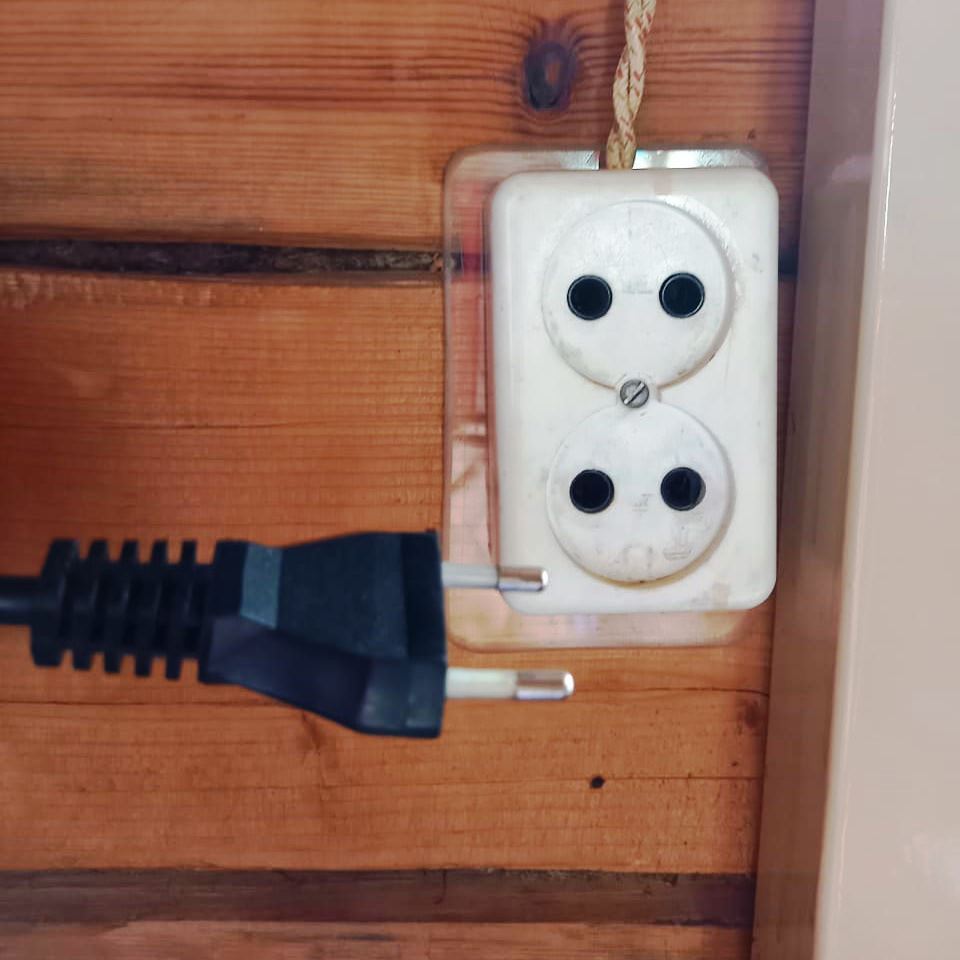
Type C plug works with all socket types used in the Alpine region
The following plug types are used in the alpine countries: C (all countries), E, F, L (Italy only), J (Switzerland only). Plug Type C is the most universal plug for the continental Europe, and thus the Alps, as it works with the sockets of all other types used in the region.
First Aid
First aid remedies are always available in the mountain huts. Hut personnel are trained to provide first aid.
Telephony and Internet
There is at least an emergency telephone line in any mountain hut. This regulation applies to all alpine huts regardless of their form of ownership. The communication services in the most distant huts may be limited to just an emergency line, often set up via a satellite link, while huts in more favorable locations may feature more services.
The internet connectivity is a very rare service in mountain huts. Not even all huts near ski slopes are able to offer the internet to their guests.
Not all mountain huts are covered by mobile networks. The signal in the mountains can be weak, especially indoors. In such a case, you may be able to make calls outdoors. The hut personnel normally know this and are able to advise you on where you can catch the network. A local SIM card is less useful than a roaming SIM card which can connect to any available mobile network and switch between them, thus providing a much better availability of the service.
What You Need to Bring for a Night in a Hut
Your short stay in a mountain hut will be more pleasant and comfortable if you come prepared and if you bring the right clothes and accessories with you.
Sleeping Bag Liner
Blankets and pillows are always provided in mountain huts. You just need to bring your own hygienic liner to use in the dormitory where bed linen is not provided. In a private room, you will normally be provided with bed linen - please see the details in your Reservation document. You do not need to bring a proper sleeping bag because it is not cold in dormitories. In alternative, simple liners can be purchased in huts for 10-20 euros. More expensive liners for sale in huts are rare.
Light Shoes
You will need clean shoes to access any area beyond the dining room. We recommend bringing classic slides with a strap over the toes made of a fast drying synthetic material. Slides with textile parts are less practical because they will take time to dry if you wear them while taking shower. Also, flip-flops with a Y-shaped strap are less practical for use in huts as they cannot be worn with socks. Many huts provide their guests with slides, but you cannot know it in advance and you cannot count on having your size, thus we recommend bringing your own slides in any case.
Change of Clothes
You will be comfortable in a hut if you bring light clothes to wear. A fleece jacket can be a practical addition in the evening.
Toiletries and Towel
You need to bring soap, shampoo, toothbrush and other toiletries you normally need. Despite many huts will provide you with a towel in private rooms, we recommend bringing your own towel unless you are absolutely sure you will receive one. Provision of towels is an optional service not addressed by the regulation. With the dormitory accommodation, you definitely need to bring a towel. We recommend microfibre towels because they are light, compact, and they dry quickly.
Plug Adapter
You need to bring a plug adapter if your charging device is not compatible with the outlets used in the hut. In the Alps, plug and socket types vary from country to country with Type C being the most commonly used.
Although electric sockets are available in huts, we recommend having a power bank with you. It is especially useful in the remote parts of the Alps, such as Friuli Dolomites, where most huts generate electricity autonomously, and it is thus limited. Also, there may be few sockets in a hut relative to the number of guests it can accommodate thus making you wait for your turn to charge your phone.
Cash
Most mountain huts cannot accept credit cards, thus you need to bring cash to pay for drinks and other additional services in huts. Italy, France and Austria use euros. Switzerland uses francs. You can withdraw cash from ATMs in the base camp locations only. On our multi-day hut-to-hut trips, we recommend having 25-35 euros or 35-45 Swiss francs per a day of hiking.
Tips and Hints
Even in the most comfortable huts, the space is still limited. Following simple rules of etiquette will make your stay in huts pleasant and help you avoid delicate situations.
Hiking Boots Out
Remember to change your hiking boots and to use clean shoes anywhere in the hut beyond the entrance area and the dining room. There is normally a dedicated place where you can leave your hiking boots.
Silence
In a hut, it is not allowed to make noise in common areas when the lights are off. If you stay late in the dining room in the evening, we recommend preparing your bed in the dormitory in advance. If you plan to get up early in the morning, it is wise to pack your backpack in the evening before.
Water and Electricity
Resources are limited in huts. Do not leave lights on or water running without a need. Warm water is especially hard to produce in huts. Many distant huts are not connected to the electric grid and generate electricity autonomously.
Keep Your Space In Order
For your clothes and accessories, use just the space you need if you sleep in a dormitory. Keep in your backpack anything you do not need when you are in bed.
Waste
You need to take with you empty bottles, packaging and any other waste you have. Naturally, this rule does not apply to the waste in the hut’s restaurant. Waste management is very expensive in huts especially in remote locations not accessible on road and not served with material ropeways.
Destination
Tell the hut manager which hut you are planning to stay overnight next, especially if you are hiking solo. You do not need to do it if you are on one of our hut-to-hut hiking trips - hut managers will contact us in case of any unforeseen situation.






